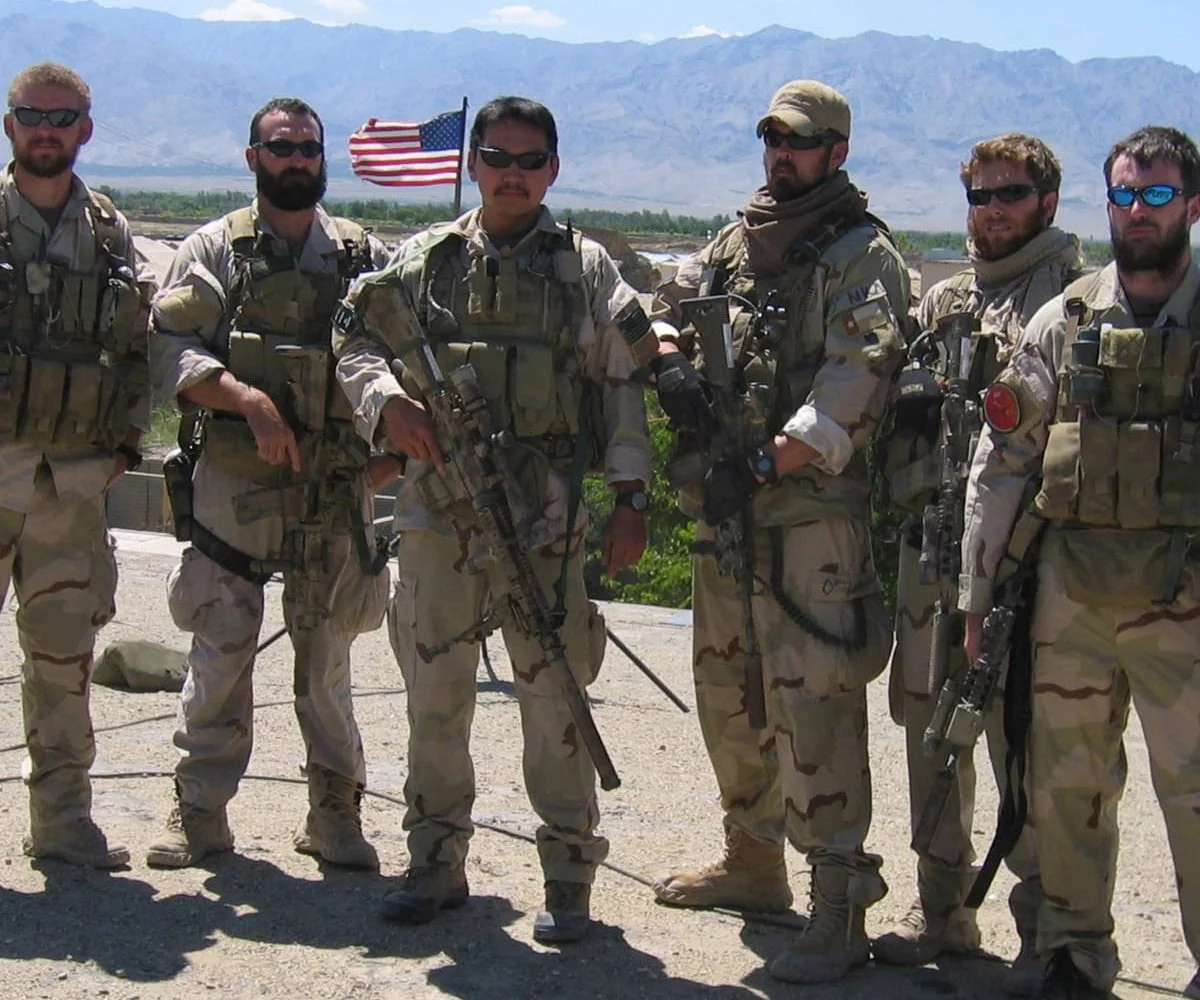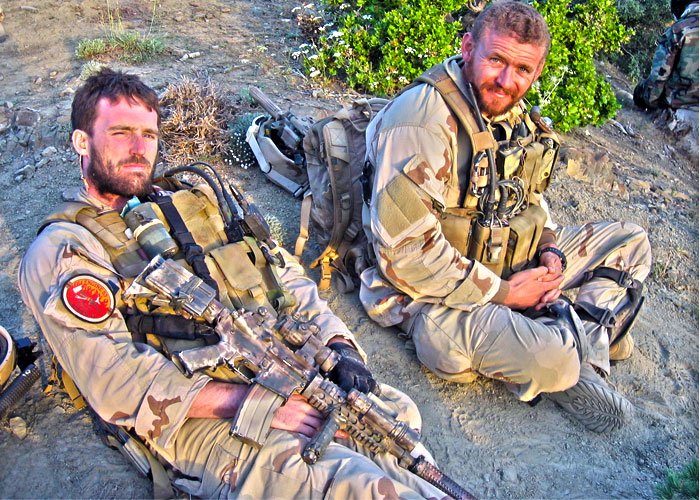Operation Red Wings Through The Eyes Of The Night Stalkers
The sun was fading behind Afghanistan’s Hindu Kush mountains the evening of June 27, 2005.
The heroes of Operation Red Wings in Afghanistan 2005
From left to right, Sonar Technician (Surface) 2nd Class Matthew G. Axelson, of Cupertino, Calif.; Senior Chief Information Systems Technician Daniel R. Healy, of Exeter, N.H.; Quartermaster 2nd Class James Suh, of Deerfield Beach, Fla.; Hospital Corpsman 2nd Class Marcus Luttrell, of Texas; Machinist's Mate 2nd Class Eric S. Patton, of Boulder City, Nev.; and Lt. Michael P. Murphy, of Patchogue, N.Y. With the exception of Luttrell, all were killed June 28, 2005, by enemy forces while supporting Operation Red Wings. (U.S. Navy)
Tasked with inserting the SEAL special reconnaissance (SR) team deep into enemy territory in unforgiving terrain
STG2 Axelson (right) with Lt. Michael Murphy
As a pilot in the 160th, Brady was the air mission commander for the operation.
He and some of his fellow “Night Stalkers” felt the SEALs’ plan, dubbed Operation Red Wings, was too risky.
The mission was to capture or kill Ahmad Shah, a Taliban commander. The three-phase plan called for inserting a four-man SR team the first night, then inserting the second element of SEALs the following night to establish an isolation zone around Shah. Finally, 150 U.S. Marines would come in to establish blocking positions for the SEALs’ assault on Shah’s compound.
The Night Stalkers’ job was to insert the SEALs on a ridgeline where the terrain left few options for landing zones. The commandos would have to descend from a rope -- fast-rope -- while the helos hovered high above the trees. That meant if the SEALs got into trouble, extraction would potentially require the use of a hoist to pull the SEALs out, which was a time-consuming and dangerous option.
Brady knew the SEALs -- Lt. Michael Murphy, Petty Officer 2nd Class Danny Dietz, Petty Officer 2nd Class Marcus Luttrell and Petty Officer 2nd Class Matthew Axelson -- had a difficult mission ahead. Marines in the area knew it was an extremely dangerous place filled with Taliban fighters.
Brady had no way of knowing at the time, but it would be the last time anyone at Bagram would ever see three of those four Americans alive.
The Army’s elite 160th Special Operations Aviation Regiment (SOAR) is known for having some of the most skilled aviators in the world, who fly the most elite special operators into some of the most austere environments on Earth, using the most advanced aircraft in the U.S. military inventory. They are famous for the roles they played in both the Battle of Mogadishu and the mission to kill Osama bin Laden but are revered throughout the special operations community for acts of valor that often never see the light of day due to the classified nature of their work.
(Photo Credit : Maj. Jeff Slinker)
An MH-47G Chinook helicopter from the 160th Special Operations Aviation Regiment.
That meant if the SEALs got into trouble, extraction would potentially require the use of a hoist to pull the SEALs out, which was a time-consuming and dangerous option.
As he approached the insertion site, Brady could see lights dotting the mountains below through his night-vision goggles.“This was a desolate part of the Hindu Kush, and at night, you wouldn’t really expect to see much,” Brady told Coffee or Die. “Not really sure who they were, but there was more activity than I expected.”
As the pilots climbed the last 1,000 feet of elevation, the AC-130 crew providing overwatch on their destination radioed to say they had to leave their position due to a mechanical issue. Brady knew that surveillance aircraft going off station without backup was supposed to result in aborting the mission.
(Photo Credit : Spc. Steven K. Young)
A UH-60 Black Hawk helicopter from 1-228th Aviation Regiment conducting hoist operations.
Four potential landing zones
He asked the AC-130 crew for one final report on the four potential landing zones the Night Stalkers had identified for the mission.
“We’ve got two military-aged males, possibly armed, on the northernmost LZ,” the crew reported. “Primary and secondary zones appear to be clear of potential threats.”
Believing the gunship could make it back on station in time for the insertion, Brady made the call to continue the mission.
Approaching the insertion point, the pilots flared the Chinook and came into a hover. As the lead aircraft descended, it became clear the LZ was on a steep slope of the mountain, making descent difficult due to the front rotors approaching the mountainside faster than the rear of the aircraft.
“Hold your right and left; hold your front and rear,” came the internal radio traffic from the flight engineer to Brady.
There were 100-foot-tall trees on all sides of the Chinook, and they were so close, the pilots had no room to sway as they descended.
“When you hear all four directions, everyone gets pretty tense,” Brady said. “It means you can’t drift any direction without crashing.”
The pilots descended to the point where the Chinook’s front rotor was just a few feet away from the mountainside with tall trees all around the aircraft. The flight crew kicked out the ropes, and the SEALs fast-roped down.
When the crew chief tried to pull the rope up, they found it was entangled below. After several tense moments of struggling to bring in the rope, they cut it loose. The odds of enemy fighters hearing the echo of the dual-rotor helicopter increased every second it remained in a hover. The SEALs did their best to hide the rope and keep their presence on the ridgeline hidden from enemy fighters.
It wasn’t an ideal insertion, but the Night Stalkers had accomplished their mission. They ascended and flew back to Jalalabad to link up with another group of SEALs and standby as a quick reaction force (QRF) in case the SR team was compromised.
At Jalalabad, Brady was approached by SEAL Commander Erik Kristensen in the command operations center. Kristensen confronted him about the decision to cut the rope at the LZ and asked whether the Night Stalkers would go back and retrieve it.
“We would have to drop a man down with a hoist in that hole of an LZ,” Brady explained. “Hoisting a man at that altitude on that kind of terrain at night is a dangerous operation. Once on the ground, they’d have to pick up the rope, hook it to themselves, and get hoisted back up. Hovering for that long over the same spot would burn the LZ and likely alert the enemy to the SR team’s presence.”
Kristensen agreed with Brady’s evaluation, and after the SR team radioed that they would be lying down for the day in their hide site, Brady and Kristensen called it a night.
As the Night Stalkers slept, the SR team was discovered by a numerically superior force of enemy fighters. They engaged in a fierce firefight, and at some point, the task force lost contact with them.
Navy SEALs : Shane Patton, Matt “Axe” Axel, James Suh, Marcus Luttrell
Brady’s maintenance officer woke him and said the SR team was in trouble, and the Night Stalkers had orders to spin up and pull the team out.
Back in the operations center, leaders were busy trying to figure out the SEALs’ last known location and calculating how many soldiers each helicopter could fly with. They finalized plans and sent the Night Stalkers on their way.
“Drop us on the high ground, and we’ll make our way to our swim buddies,” Kristensen told Brady.
Danny Dietz, Marcus Luttrell
The two Chinooks -- Turbine 33 and Turbine 34 -- were packed with 16 SEALs each, plus the Night Stalker pilots and crewman. Flying toward Jalalabad en route to the last known position of the SEALs, they received word from Bagram on the number of men they could have on board each aircraft and still fly at the extreme elevation. They would have to offload eight SEALs from each helicopter before continuing.
The plan was for the SEALs to fast-rope onto the ridgeline above the original LZ. The Night Stalkers would then circle back and pick up the remaining SEALs who offloaded at Jalalabad.
Arriving at the insertion point on the ridgeline, Turbine 33 descended into a hover. Graham watched from Turbine 34 as Turbine 33’s ramp lowered and the crewman walked onto it to observe the landing zone below. Graham’s aircraft pulled off to the right to circle around and insert their payload of SEALs after Turbine 33 moved off to allow their entrance.
That’s when Staff Sergeant Steven Smith, the flight engineer in the rear of Turbine 34, saw a smoke trail emerge from the tree line directly toward Turbine 33. The projectile flew through the open ramp of the Chinook and exploded inside. Turbine 33’s nose dipped down, and the aircraft slid to the left, appearing to almost recover. Then the helo’s blades started hitting each other, and the aircraft rolled to the right before inverting as it descended to the mountainous terrain below.
Smith and the others in Turbine 34 watched helplessly as the Chinook full of their fellow aviators -- their friends -- crashed into the mountain and erupted in a ball of flames.
“Al and Kip were on the ramp when the RPG impacted,” Smith, who witnessed the horrific event, recalled. “They rode it all the way in that way.”
Graham and his co-pilot whipped their Chinook around to look for survivors. As they were turning around, Graham saw five Black Hawks performing a star-cluster evasion. Turbine 34 started taking heavy gunfire from unseen fighters below. They broke off and flew out of reach of the enemy fire.
Graham reported the situation back to Bagram. Receiving the transmission, Brady couldn’t believe it. He would have been on that bird were it not for the last-minute change. He asked Graham to repeat, unable to register what he had just heard.
The remaining Night Stalkers prepared for a rescue operation. Navy SEALs, Army Rangers, and other Joint Special Operations Command (JSOC) personnel loaded onto five Chinooks. All the men were anxious, angry, and ready to retrieve their brothers in arms.
The Chinooks took off toward the mountains once again, but as they climbed in elevation, severe weather rolled in. Thunder boomed as lightning struck all around them.
Operation Red wings
The order was given to again abort the mission and return to base. It was a gut-wrenching decision for everyone on the mission, as they knew the original SEALs on the SR team were fighting for their lives and one of their own aircraft and crew was burning on the side of a mountain.
As the next night approached, the task force went to work, planning another insertion onto the deadly ridgeline
Army Rangers : sets out on a mission to rescue the lone survivor of a SEAL team that came under attack in the mountains of Afghanistan
The Night Stalkers again loaded their Chinooks with Rangers and SEALs and took off toward the mountains.
Arriving on site, the task force members fast-roped in. The extreme height of the trees made the full length of rope -- approximately 90 feet -- necessary. Many of the men suffered scorched hands from gripping the rope through gloves for such a long descent.
Once on the ground, they started their search for casualties, potential survivors, and sensitive equipment.
As the Night Stalkers flew back to Bagram, the JSOC ground force that had convoyed to the crash radioed to the task force that they had secured the site. There were no survivors.
The JSOC troops, along with their newly arrived reinforcements, went to work recovering those killed in action as well as sensitive equipment that could not fall into enemy hands. They then used explosives to clear out a large enough area for Chinooks to land when they came back.
One by one, the Rangers and SEALs loaded the fallen onto the Chinooks and headed back to Bagram with their brothers. The flight back was pure silence. The loss weighed heavy on the men.
The C-17 sat on the runway with the ramp down, waiting to receive the 16 interment cases containing the fallen warriors. Brady stood next to a SEAL commander -- both had to take command of their respective units when Reich and Kristensen were killed on Turbine 33. Their war-weary faces were chiseled stone as they watched the task force solemnly load 16 flag-draped internment cases into the C-17.
Brady said it seemed like the whole base turned out to give the fallen a proper sendoff. As the cases were being loaded, a SEAL ran up to the new SEAL commander and placed a written note in his hand. The note said that Marcus Luttrell was alive at a nearby village. The SEAL commander broke down and cried at the desperately needed positive news.
U.S. Navy SEALs : Sr. Chief Petty Officer Dan Healy & Hospital Corpsman First Class Marcus Luttrell in Afghanistan
Fallen Night Stalkers of the 160th SOAR included
-Staff Sergeant Shamus O. Goare
-Chief Warrant Officer Corey J. Goodnature
-Sergeant Kip A. Jacoby
-Sergeant First Class Marcus V. Muralles
-Major Stephen C. Reich
-Sergeant First Class Michael L. Russell
-Chief Warrant Officer Chris J. Scherkenbach
-Master Sergeant James W. Ponder III
The members of the task force said their final goodbyes. The C-17 closed its ramp and taxied down the runway and took flight. The fallen warriors were now on their way home.
The rescue operation, known as Operation Red Wings II, continued for weeks. Almost every variety of special operations troops in the U.S. military inventory participated in a coordinated effort through some of Afghanistan’s most dangerous and austere terrain during the search for their brothers -- both alive and fallen.
Navy SEAL Marcus Luttrell was the only survivor from the initial four-man SEAL reconnaissance element.
For the Night Stalkers of the famed 160th Special Operations Aviation Regiment, the war on terror continued.








